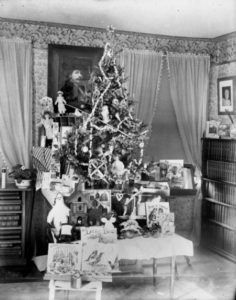
Christmas Tree in Wisconsin State Hospital, 1895
Asylum patients were often lonely and neglected by their families during the holidays, though a few superintendents, like Dr. E.H. Williams, the assistant physician at Matteawan State Hospital (1897), didn’t think the holidays mattered much to them. He believed that the insane couldn’t handle changes in routine and wouldn’t appreciate celebrations, anyway.
Most asylum superintendents didn’t believe this, and tried hard to make holidays like Christmas special. Public charities and organizations often helped them. They donated food and clothing, and churches brought groups to visit and sing. Usually, meals were also festive and special. The Milwaukee Sentinel described a dinner meal in 1903 that included rabbit stew, oysters, and plum pudding. The evening before, staff had distributed bags of candy and fruit as patients enjoyed music and danced. Festivities like these undoubtedly meant a great deal to patients burdened by the monotonous regimen that was such a large part of their treatment.

Christmas Turkeys Displayed Outside Spencer State Hospital, formerly Second Hospital for the Insane, circa 1924, courtesy WVU Libraries
Very often, asylums would decorate Christmas trees and their public areas; superintendents also made sure that every patient received a gift, using money that had been set aside for that purpose or relying on donations from charities.

Patients and Staff at Christmas Party at State Hospital, Jamestown, courtesy Historical Society of North Dakota
It was important that no one be forgotten, and all these efforts to provide a bit of cheer and comfort undoubtedly helped patients through an especially difficult time. Likewise, the staff enjoyed the break in routine, and received the psychic boost that comes from helping others.